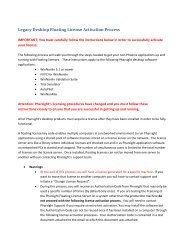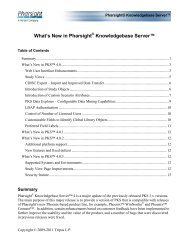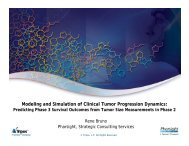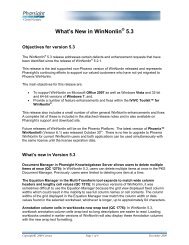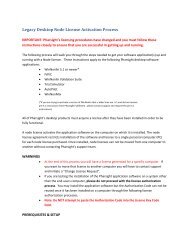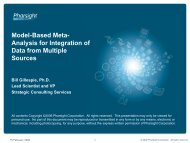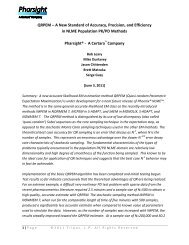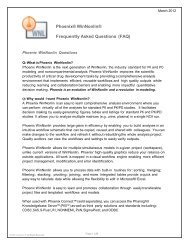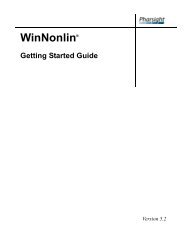A clinical utility index (CUI) openly evaluates a product's attributes ...
A clinical utility index (CUI) openly evaluates a product's attributes ...
A clinical utility index (CUI) openly evaluates a product's attributes ...
You also want an ePaper? Increase the reach of your titles
YUMPU automatically turns print PDFs into web optimized ePapers that Google loves.
FOR GLOBAL BUSINESS AND MARKETING LEADERS<br />
IN DESIGNING CLINICAL TRIALS, THE PHARMA INDUSTRY has been primarily<br />
concerned with a drug’s efficacy, and therefore, modeling and<br />
simulation technologies used for those designs have also focused on efficacy.<br />
But the <strong>clinical</strong> <strong>utility</strong> and economic worth of a compound depends<br />
on many dimensions beyond efficacy, including important influences<br />
such as target population, product formulation, and patient compliance.<br />
To enhance market share and value to patients, pharma companies must<br />
consider those dimensions earlier in the drug development process.<br />
One way to do that is with the use of a <strong>clinical</strong> <strong>utility</strong> <strong>index</strong> (<strong>CUI</strong>),<br />
which quantifies factors like a product’s efficacy, safety, cost, and contribution<br />
to quality of life—and makes trade-offs transparent to decision<br />
makers. A <strong>CUI</strong> provides a single metric for multiple dimensions of benefit<br />
and risk and captures expert opinion on the therapeutic importance<br />
of various product characteristics. It also enhances communication<br />
between discovery, development, and the commercial side. >><br />
A <strong>clinical</strong><br />
<strong>utility</strong> <strong>index</strong><br />
(<strong>CUI</strong>) <strong>openly</strong><br />
<strong>evaluates</strong><br />
a product’s<br />
<strong>attributes</strong>—<br />
and chance<br />
of success<br />
BY BOB KORSAN<br />
KEVIN DYKSTRA<br />
AND WILLIAM PULLMAN<br />
Bob Korsan (bobk@pharsight.com<br />
or (650) 314-3843) is director<br />
of decision services, and Kevin Dykstra<br />
is a senior scientist, both for<br />
Pharsight. Dr. William Pullman is<br />
senior vice president and global<br />
head of <strong>clinical</strong> discovery and<br />
human pharmacology for Aventis<br />
Pharmaceuticals.
Multiple Dimensions<br />
Getting the right information to physicians about the best <strong>clinical</strong><br />
use of a drug becomes more challenging as the number of<br />
available therapies grows. In his article “Choosing Which Drug<br />
to Prescribe” (Medscape General Medicine, 6 August 2003),<br />
Tomas Kramer, MD pens: “Recently, a great deal has been written<br />
urging clinicians to practice ‘evidence-based medicine,’ in<br />
which <strong>clinical</strong> decision making is based on scientifically derived<br />
data. The problem with this, of course, is there is very little evidence<br />
upon which to practice evidence-based medicine.”<br />
Treatment choices A prescribing physician must choose a<br />
therapy that gives the best balance of efficacy, side effects,<br />
safety, ease-of-use, and quality-of-life benefits for a given<br />
patient. Analytic tools developed in pharmacological science<br />
and operations/market research can organize knowledge from<br />
different sources into a decision making framework. (See “<strong>CUI</strong><br />
Model” below.) First, modeling is used to predict, design, and<br />
learn. A drug candidate’s likely <strong>clinical</strong> performance is modeled<br />
using information from related therapies as well as pre<strong>clinical</strong><br />
and early <strong>clinical</strong> data. Next, the predicted product<br />
profile(s) are evaluated using the <strong>CUI</strong>.<br />
Clinical <strong>utility</strong> Every medical therapy has benefits and risks.<br />
The relative importance of these characteristics depends on the<br />
disease, patient, and how the drug is used (for example, dosage<br />
or concomitant therapy). A <strong>CUI</strong> is a transparent means of<br />
weighing and quantifying a compound’s trade-offs. It provides a<br />
scale to compare product profiles and measure the impact of scientific<br />
and market assumptions. It can be used at low cost (a<br />
small amount of time and effort on the part of the drug development<br />
team) and early in a <strong>clinical</strong> program (Phases I and II).»<br />
Clinical <strong>utility</strong> is defined as the net benefit of treatment to<br />
the patient as perceived by the prescribing physician or a surro-<br />
<strong>CUI</strong> Model<br />
A model-based approach to decision making, integrating scientific<br />
and market information, is the basis of the <strong>clinical</strong> <strong>utility</strong> <strong>index</strong> (<strong>CUI</strong>).<br />
Clinical and<br />
Pre<strong>clinical</strong> Data<br />
Exploratory Data<br />
Analysis<br />
Efficacy Dose-<br />
Response Model<br />
Simulation<br />
Safety Dose-<br />
Response Model<br />
Physician Market<br />
Research<br />
Clinical<br />
Utility Model<br />
Integration: <strong>CUI</strong><br />
Overall, a <strong>clinical</strong> <strong>utility</strong> <strong>index</strong> can<br />
be used to assess a product’s chance<br />
of success in the marketplace.<br />
Dose Benefit<br />
Model<br />
Response/Efficacy*<br />
Optimal Dose Response<br />
25<br />
f(dose) u(dose)<br />
20<br />
15<br />
10<br />
5<br />
0<br />
BEST DOSE<br />
In this dose benefit model,<br />
the optional dose emerges<br />
at the point before efficacy<br />
begins to be penalized by<br />
increased side effects.<br />
PENALTY<br />
0 0.2 0.4 0.6 0.8 1<br />
Dose<br />
*Definition: Improvement in efficacy score from baseline relative to placebo<br />
Information Flow<br />
The <strong>CUI</strong> uses various sources of information to assess competing treatments' benefits.<br />
Identify Critical<br />
Treatment<br />
Attributes and<br />
Relative Weights<br />
Treatment Response<br />
Models<br />
Expert Opinion<br />
Identify Metrics<br />
and Relevant<br />
Response Levels<br />
for Each Attribute<br />
Probability<br />
of Individual<br />
Attribute Levels<br />
Assign Preference<br />
Values for Each<br />
Response Level<br />
<strong>CUI</strong><br />
Framework<br />
Collective<br />
Product<br />
Profiles<br />
<strong>CUI</strong> Distributions<br />
for Competing Treatments<br />
1<br />
P(<strong>CUI</strong> < X)<br />
A<br />
B<br />
0 100<br />
Here, treatment B is expected<br />
to be superior to A<br />
SOURCES: Pharsight<br />
A PharmExec Graphic
gate decision maker such as an HMO making formulary decisions.<br />
A <strong>CUI</strong> quantifies the contribution of each attribute in<br />
the product profile (label) using physician preference data, if<br />
available, or by relying on <strong>clinical</strong> advisors and other internal<br />
expertise. The latter is less expensive, and may be more appropriate<br />
early in a development program.<br />
Metrics and methods When modeling prescribing physician<br />
behavior, a <strong>CUI</strong> is similar to models used in later <strong>clinical</strong> development<br />
(Phases III and IV). Both <strong>CUI</strong> and conjoint analysis<br />
attempt to weigh the relative value of treatment <strong>attributes</strong> and to<br />
capture that information in a single metric for comparison<br />
of competing treatment options. A <strong>CUI</strong> differs<br />
from conjoint and discrete choice analyses in its<br />
source of information and cost. Tools such as discrete<br />
choice analysis actually survey a large number<br />
of physicians asking them to choose between hypothetical<br />
product profiles. The trade-offs among elements<br />
of the competing product profiles are inferred<br />
from physician responses. A similar tool goes by the<br />
name of “conjoint analysis.” Both tools use slightly<br />
different methodologies to arrive at the same empirical<br />
result and a large number of physicians must be<br />
interviewed to obtain a meaningful model, leading to high cost.<br />
Product position <strong>CUI</strong>, in addition to lower cost, offers specific<br />
benefits when used in lieu of or as an early measure of physician<br />
prescribing behavior. Construction of a <strong>CUI</strong> leads the<br />
development team to identify those product <strong>attributes</strong> critical<br />
to the patient. A <strong>CUI</strong> focuses development team efforts on<br />
exploring the most valuable region of treatment—not necessarily<br />
the most efficacious—and the best market position. Further,<br />
<strong>CUI</strong> can be used to examine differences between internal<br />
team opinion and outside physician input. Multiple <strong>CUI</strong>s can<br />
explore the potential influence of non-prescriber decision makers,<br />
such as the FDA or third-party payers.<br />
Practical Tool<br />
In <strong>clinical</strong> practice, the patient’s decision maker is generally the<br />
prescribing physician. Ideally, the development process will<br />
result in drugs that are just what the prescribing physician<br />
ordered. The framework for the <strong>CUI</strong> is elicited from the project<br />
team. Attribute utilities and weights are determined based on<br />
physician preference data, if available, or internal expert opinion.<br />
When combined with models of what the body does to the<br />
drug (pharmacokinetics) and what the drug does to the body<br />
(pharmacodynamics), the <strong>CUI</strong> is a tool for understanding the<br />
benefit of the drug to the patient, relative to competing therapies.<br />
Because these models also include the uncertainty in the<br />
drugs effects, they can also be used to predict the outcomes of<br />
proposed development trials. As a development program progresses,<br />
ongoing or completed trial results provide learning and<br />
models are updated. Model output can be broken into categories<br />
that show the chance of achieving a given product profile<br />
and <strong>CUI</strong>, given what is known about the drug. The chances of<br />
different product profiles can, in turn, be linked to financial<br />
models for decision making.<br />
Such models have been used successfully to support better<br />
choices in <strong>clinical</strong> development, as illustrated in the following<br />
case studies. Each is derived from a real project conducted for a<br />
client in the pharmaceutical industry. Indications and other<br />
information may have been blinded to protect confidentiality.<br />
The use of a <strong>CUI</strong> leads<br />
development efforts<br />
to explore the most<br />
valuable region<br />
of treatment<br />
—not necessarily the<br />
the most efficacious.<br />
Case Study: Efficacy vs Side Effects<br />
<strong>CUI</strong>s needn’t be complex to prove useful. A simple <strong>index</strong>, constructed<br />
using a penalized dose-response model, was used to<br />
explicitly value trade-offs between increased efficacy and side<br />
effects for a new chemical entity (NCE) with a novel mechanism<br />
of action. This <strong>index</strong> formed the basis for the choice of<br />
best dose, which was in turn used in simulations to optimize<br />
trial strategy for a phase II dose-ranging<br />
trial.<br />
The compound was a psychiatric<br />
medication with a novel mechanism of<br />
action and little prior information was<br />
available to inform expectations for<br />
efficacy or side effects. Phase I safety<br />
trials and one inconclusive Phase IIa<br />
trial had been completed, leaving high<br />
uncertainty in efficacy and doseresponse<br />
for the NCE.<br />
A modeling project was undertaken<br />
to improve efficiency and informativeness of Phase II<br />
trial strategies, and to optimize the treatment regimen. First,<br />
drug and disease models were developed to quantify expectations<br />
and uncertainties about efficacy and side effects. This<br />
formed the basis for a penalized dose-response model, developed<br />
to provide a <strong>utility</strong> criterion for choosing best dose. (See<br />
“Dose Benefit Model,” page 90.)<br />
A model of various dosing strategies was developed. Simulations<br />
assessed each design’s performance compared to fixeddose<br />
dose-ranging. The criteria for trial quality were: closest<br />
estimate of best dose (Dbest) and minimum effective dose<br />
(MED), as measured using the penalized dose function (<strong>utility</strong><br />
<strong>index</strong>). The simulations indicated an advantage to particular<br />
designs because the uncertainty in safety and efficacy was<br />
understood and a <strong>utility</strong> <strong>index</strong> provided a single, quantitative<br />
measure of that best dose.<br />
Case Study: Identifying No-Gos<br />
Evaluating a potential next-in-class drug against successful<br />
predecessors requires close comparison of risk–benefit profiles.<br />
A <strong>CUI</strong> is ideal for the job.<br />
A new selective estrogen receptor modulator (SERM) was<br />
in early human trials. Concern had risen over a possible side<br />
effect, endometrial hypertrophy, which could lead to cancer<br />
if unchecked. Further trials posed not only financial risk but<br />
possible health risks for hundreds of women if this side<br />
effect proved troublesome. To explore whether any dose of<br />
the new candidate could be expected to perform acceptably<br />
against the popular first-in-class drug, Evista (raloxifene),<br />
Aventis Pharmaceuticals turned to modeling and simulation.<br />
Dose–response models for efficacy versus side effects were<br />
developed from early trials of the new SERM and prior information<br />
on related compounds. An initial version of the <strong>CUI</strong><br />
was elicited from project team members. They identified 10<br />
critical <strong>attributes</strong> of the product profile. For each attribute, possible<br />
attribute levels and their <strong>clinical</strong> value were defined using a<br />
preference ratio. The <strong>attributes</strong> were ranked and their impor-
Clinical Impact<br />
SOURCE: Pharsight<br />
tance weighted. The team reviewed the <strong>attributes</strong><br />
to ensure that they described all important and relevant<br />
<strong>clinical</strong> issues, captured the range of outcomes<br />
for each attribute, and reflected the<br />
expected <strong>clinical</strong> value of possible outcomes.<br />
Simulation produced a distribution of likely<br />
patient outcomes for each attribute. Each distribution<br />
was parsed into categories, each of which had<br />
a known likelihood of occurrence. Every unique<br />
combination of attribute levels yielded one possible<br />
<strong>CUI</strong> score. The probabilities of the attribute levels<br />
for a given <strong>CUI</strong> score yielded the likelihood of that<br />
score being the “true” product <strong>CUI</strong>. The combined<br />
set of possible <strong>CUI</strong> scores and their likelihoods were<br />
characterized as a probability distribution, describing<br />
the expected <strong>CUI</strong> values for the new SERM and<br />
its primary competitor.<br />
Simulations revealed that the new SERM, as<br />
reflected in its <strong>CUI</strong> distribution, was expected to perform<br />
worse than the established competition at all doses. Sensitivity<br />
The authors would like to acknowledge Shawne Neeper and T. J. Carrothers<br />
(both of Pharsight) for their efforts in developing this article.<br />
Trial designs based on modeling and simulation can<br />
eliminate Phase IIa/IIb trials, saving time and money.<br />
Pre<strong>clinical</strong> I-IIa IIb III Submission<br />
Phase duration Same Same Large Same Decline<br />
decline or decline<br />
Phase cost Increase Increase Decline Decline (fewer Decline<br />
failed trials)<br />
Phase PoS Same Higher Increase Increase Increase<br />
attrition<br />
A <strong>CUI</strong> can<br />
optimize<br />
the trade-offs<br />
in speed, cost,<br />
and learning,<br />
helping<br />
developers<br />
spot poor<br />
candidates<br />
early.<br />
analysis made it clear that the drug<br />
could have performed well except<br />
for the key side effect; an identical<br />
drug without the risk of endometrial<br />
proliferation would surpass<br />
the competition. The upcoming<br />
trial would have been quite expensive<br />
and those funds could be used<br />
more effectively on other compounds.<br />
Consequently, it was<br />
decided to progress a more promising<br />
back-up compound that did<br />
not appear to have this liability in<br />
pre<strong>clinical</strong> testing.<br />
Quicker Wins<br />
In early drug development, a <strong>CUI</strong> makes optimal<br />
use of internal expertise and minimizes the cost<br />
of focusing development on the best product<br />
profile—not the most efficacious one. By using<br />
comparisons to current competitors and new<br />
entries under development, drugs that have no<br />
differentiation can be weeded out earlier from a<br />
crowded marketplace, providing more resources<br />
for R&D. It can substantially lower the cost of<br />
delivering a beneficial drug to the marketplace.<br />
Additional benefit is gained by the use of<br />
modeling and simulation analyses in Phases II<br />
and III. By investing in these more intensive and<br />
adaptive early phase analyses, developers can<br />
spot poor drug candidates earlier and improve<br />
positioning of those going into Phase III. The use<br />
of a <strong>CUI</strong> can optimize the trade-offs in speed,<br />
cost, and learning during these phases, leading<br />
to quicker wins. The end result is a label that supports the best<br />
therapeutic use of a new therapy, and offers the best patient<br />
benefit. Thus, the <strong>CUI</strong> is a valuable communication, decision<br />
making and optimization tool.<br />
© Reprinted from PHARMACEUTICAL EXECUTIVE, March 2005 Printed in U.S.A.<br />
Copyright Notice Copyright by Advanstar Communications Inc. Advanstar Communications Inc. retains all rights to this article. This article may only be viewed or printed (1) for personal use. User may not actively save<br />
any text or graphics/photos to local hard drives or duplicate this article in whole or in part, in any medium. Advanstar Communications Inc. home page is located at http://www.advanstar.com.<br />
800 W. El Camino Real, Suite 200 • Mountain View, CA 94040<br />
CONTACTS:<br />
INVESTORS EVC Group<br />
Douglas Sherk<br />
(415) 896-6820<br />
Jennifer Beugelmans<br />
(415) 896-6820<br />
MEDIA EVC Group<br />
Sheryl Seapy<br />
(415) 272-3323





